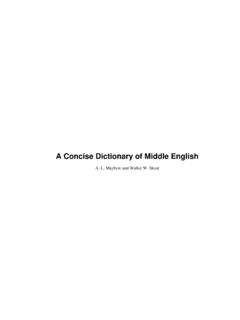Transcription of A Frequency Dictionary of Japanese - BestWeb
1 A Frequency Dictionary of Japanese is an invaluable tool for all learners of Japanese , providing a list of the 5,000 most commonly used words in the on combined corpora of over 107 million words covering spoken and written, fiction and non-fiction registers this Dictionary provides the user with a detailed Frequency -based list, as well as alphabetical and part-of-speech entries in the Frequency list feature the English equivalent and a sample sentence with English translation.
2 The Dictionary also contains 25 thematically organized lists of frequently used words on a variety of topics such as food, weather, occupations and leisure. Numerous bar charts are also included to highlight the phonetic and spelling variants across Frequency Dictionary of Japanese enables students of all levels to maximize their study of Japanese vocabulary in an efficient and engaging way. It is also an excellent resource for teachers of the Frequency Dictionary of JapaneseYukio Tono is Professor at the Graduate School of Global Studies, Tokyo University of Foreign Studies.
3 Makoto Yamazaki is Associate Professor at the Department of Corpus Studies, the National Institute for Japanese Language and Linguistics. Kikuo Maekawa is Professor at the Department of Corpus Studies, the National Institute for Japanese Language and Frequency DictionariesGeneral Editors:Paul Rayson, Lancaster University, UKMark Davies, Brigham Young University, USAE ditorial Board:Michael Barlow, University of Auckland, New ZealandGeoffrey Leech, Lancaster University, UKBarbara Lewandowska-Tomaszczyk, University of Lodz, PolandJosef Schmied, Chemnitz University of Technology, GermanyAndrew Wilson, Lancaster University, UKAdam Kilgarriff, Lexicography MasterClass Ltd and University of Sussex, UKHongying Tao, University of California at Los Angeles, USAC hris Tribble, King s College London, UKOther books in the series.
4 A Frequency Dictionary of ArabicA Frequency Dictionary of Mandarin ChineseA Frequency Dictionary of CzechA Frequency Dictionary of American EnglishA Frequency Dictionary of FrenchA Frequency Dictionary of GermanA Frequency Dictionary of PortugueseA Frequency Dictionary of Russian (forthcoming)A Frequency Dictionary of SpanishThe Frequency Dictionaries are all available as data CDs. These CD versions are specifically designed for use by corpus and computational linguists.
5 They provide the Frequency corpus in a tab-delimited format allowing users the flexibility to process the material for their own research Frequency Dictionary of JapaneseCore vocabulary for learnersYukio Tono, Makoto Yamazaki and Kikuo MaekawaLONDON AND NEW YORKR outledgeTaylor & Francis GroupFirst published 2013by Routledge2 Park Square, Milton Park, Abingdon, Oxon OX14 4 RNSimultaneously published in the USA and Canadaby Routledge711 Third Avenue, New York, NY 10017 Routledge is an imprint of the Taylor & Francis Group, an informa business 2013 Yukio Tono, Makoto Yamazaki and Kikuo MaekawaThe right of Yukio Tono, Makoto Yamazaki and Kikuo Maekawa to be identified as authors of this work has been asserted by them in accordance with sections 77 and 78 of the Copyright.
6 Designs and Patents Act rights reserved. No part of this book may be reprinted or reproduced or utilised in any form or by any electronic, mechanical, or other means, now known or hereafter invented, including photocopying and recording, or in any information storage or retrieval system, without permission in writing from the notice: Product or corporate names may be trademarks or registered trademarks, and are used only for identification and explanation without intent to Library Cataloguing in Publication DataA catalogue record for this book is available from the British LibraryLibrary of Congress Cataloging in Publication DataTono, Yukio.
7 A Frequency Dictionary of Japanese : core vocabulary for learners / Yukio Tono, Kikuo Maekawa and Makoto cm. (Routledge Frequency dictionaries) Includes bibliographical references and index. 1. Japanese language Word Frequency Dictionaries. 2. Japanese language Dictionaries. 3. Japanese language Textbooks for foreign speakers English. I. Makawa, Kikuo. II. Yamazaki, Makato. III. Title. 321 dc232012021445 ISBN: 978-0-415-61012-4 (hbk)ISBN: 978-0-415-61013-1 (pbk)ISBN.
8 978-0-415-60104-7 (CD)Typeset in Parisine by Graphicraft Limited, Hong Kong ContentsThematic vocabulary lists | viSeries preface | viiAcknowledgments | ixAbbreviations | xIntroduction | 1 References | 9 Frequency index | 10 Alphabetical index | 247 Part of speech index | 302 Word types (origins) | 357 Thematic vocabulary lists14 Plants | 14115 School | 15116 Shops | 16017 Sports | 16918 Taste | 17819 Time | 18820 Transportation | 19721 Weather | 20622 Words including letters of the alphabet | 21523 o-/go- (Honorifics)
9 | 22424 Honorific expressions | 23325 Numbers/numerals | 243 1 Animals | 20 2 Body | 29 3 Clothing | 38 4 Colors | 47 5 Countries | 55 6 Emotions | 65 7 Family | 77 8 Food | 86 9 Furniture | 9610 Greetings | 10511 House | 11412 Leisure | 12313 Occupations | 132 Series prefaceFrequency information has a central role to play in learning a language. Nation (1990) showed that the 4,000 5,000 most frequent words account for up to 95 per cent of a written text and the 1,000 most frequent words account for 85 per cent of speech.
10 Although Nation s results were only for English, they do provide clear evidence that, when employing Frequency as a general guide for vocabulary learning, it is possible to acquire a lexicon which will serve a learner well most of the time. There are two caveats to bear in mind here. First, counting words is not as straightforward as it might seem. Gardner (2007) highlights the problems that multiple word meanings, the presence of multiword items, and grouping words into families or lemmas present in counting and analysing words.






